Nightclubs – for many of us, for good or bad – were a rite of passage, a setting for myriad “life-shaping moments”, in the words of Dave Haslam, a DJ and stalwart at the Haçienda in Manchester and author of Life After Dark: A History of British Nightclubs and Music Venues. So last year, when news broke of the dramatic, near-halving in the number of clubs in the UK, from 3,144 in 2005 to 1,733 in 2015, columnists lined up either to mourn their passing or dance joyously on their graves.
Further indignity would soon be heaped on nightclubs. Earlier this year the Office for National Statistics announced the annual “inflation basket”: the 700-plus list of goods and services that are used to calculate the rate at which prices are changing. There was a clutch of new entries for 2016, including coffee pods, women’s leggings and computer game downloads. There were also some telling omissions of things that are no longer so relevant to Britain now. Among the things taken off the list were: CD-Roms, rewritable DVDs and nightclub entry fees.
What has happened to explain this dramatic fall from favour? Well, it’s something of a perfect storm of factors, but the bottom line is that young people are now less inclined to gravitate towards nightclubs at the end of an evening. Contributing factors include: the spiralling costs of student life; the unstoppable rise of festivals; the launch of apps such as Tinder and entertainment sites like Spotify; the fact that nightclub selfies look dark and not especially aspirational.
In some ways, though, nights out have simply diversified, as the following pages show. Where once there was only pubbing and clubbing, adventurous night owls can now choose between street-food night markets, live cinema “experiences” like Secret Cinema, exercise classes that kick off at midnight and a revival of bingo.
“People don’t only go to the pub any more,” says Lucy Woodbridge, who organises Dino Snores for Grown-Ups, an occasional adult “sleepover” at the Natural History Museum in London. “They’re looking for surprise, something that makes them go, ‘Whoa, what is that?’”
Nightclubs have faced considerable external pressures, too, in the past decade. Alongside greater competition from pubs and bars, which since 2005 have been permitted to serve booze after 11pm, club owners’ lives have often become entangled with increased regulation. “When we had the End we had a 24-hour licence, we could do what we wanted, it was so free,” recalls Layo Paskin, whose club ran in central London from 1995 to 2009, a golden age – its resident DJs included Fatboy Slim and Roni Size. “But when I talk to people who are still involved, now the police, the council, everyone is all over you. You are trying to get hundreds, maybe 1,000-plus people who are there to have a good time to behave impeccably all the time. It’s kind of tricky.”
While it is easy to become nostalgic over nightclubs, clearly one generation outgrew them and the next weren’t so keen to go to them. A Guardian survey of 196 millennials earlier this year found that expense was a big turnoff. For students already buried under £9,000 annual tuition fees, a night of taxis, entrance fees and overpriced drinks was an extravagance they couldn’t afford. They would rather save their money for a blowout at a summer festival or a city break. And if going to a nightclub was always an unreliable way to find a new squeeze, online dating platforms have made it look positively prehistoric.
This also fits with the picture of Generation Abstemious: one-fifth of Britons aged 16-24 are now teetotal, a number that has increased 40% between 2005 and 2013. “People don’t drink as much as they used to because they don’t want to have the hangovers, because they think it’s a waste of time,” says Greg Drach, co-founder of Midnight Runners, whose six-mile bootcamp runs, accompanied by music, are proving a hit with twenty- and thirtysomethings who still want a night out. The Midnight Runners often end up finding somewhere to dance, as well. “People are still going out, to gigs, to events of all kinds, and to dance,” says Haslam. “A certain kind of venue – the traditional chain-owned high street discotheque – has lost its appeal; it’s those establishments that are closing. People are frequenting bars, and of course with the licensing changes many of them open late and feature DJs. But there are also some great ‘found’ spaces like old warehouses and mills, even churches.”
Paskin, who now owns the Palomar restaurant in Soho, thinks a new generation is just putting their stamp on how they want to find their fun. But that doesn’t mean nightclubs are quite as anachronistic as CD-Roms. “As good as drinking and eating and socialising can be,” he says, “dancing is amazing in a totally different way. It’s not like everyone is going to stop dancing – we’ve been dancing since we were in the caves.”
Theme nights: ‘It’s queering the norm and bringing fabulosity’
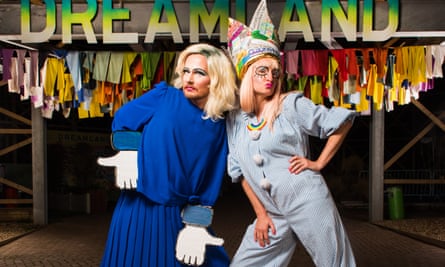
Perhaps it seemed inevitable that when Amy Redmond moved to Margate three years ago the town’s nightlife would soon feel her presence. Redmond is better known as Amy Zing, co-founder of the infamous London club night, queer collective and, in their words, “massive genderfuck” Sink the Pink – feted for its celebrations of dancing, drag artistry and dressing up that have carried them from house parties to the 3,000-capacity Troxy, to Pride, to festivals around the world.
Cockles & Muscles launched in Margate last August. “It’s a seaside version of Sink the Pink,” Redmond explains. “Queering the norm and bringing fabulosity.” She wondered at first whether a small seaside town with only one gay bar would welcome such an extravaganza, but then she realised that “there’s something inherently queer about Margate in its punk spirit – the culture and arts scene is so contemporary and progressive; there’s a queer arts culture here that is different to anywhere I’ve ever known.” And perhaps even more importantly, she recognised that “People love the silly here. And when you don’t define it as being about sexuality, people realise we’re all just dressing up and having lots of fun, and you can have your mind opened.”
Each event is themed: there was a Halloween party and an Under the Sea, and one that took as its inspiration Margate itself – people dressed as each other, or as local landmarks. One went as an estate agent’s sign – a nod to the rapid gentrification of the area. Redmond went dressed as the Lido tower, but changed the letters to read “DILDO”.
Ted Rogers, 24, moved to Margate last September. An artist and sometime dancer for Sink the Pink, he is a staunch supporter of Cockles & Muscles. “It challenges the crap out of everyone,” he says of its impact on the town. “Like love terrorism.” He says the average Cockles & Muscles night is “like an off crossover of an adult nursery and a sex party. By the end of the night everyone’s covered in floor grime and glitter and a bit naked. It’s sexy and trashy. It’s a love-binge, and it feels a completely necessary, wonderful response to the state of the world right now.”
Last weekend, Margate saw its first Pride, and when we speak, Redmond is busy mapping out its route: floats, rollerskates, a procession through town past the lifeboats and the Turner Contemporary, home-made banners in the station, a drag race outside Sundowners, dolled-up shopfronts and DJs at Dreamland funfair. That evening she is making carnival crowns at Out Margate, the youth programme she put together with Glynfamous, her Sink the Pink co-founder, and which she describes as being “like a gay WI”. Her influence on the town’s nightlife is not solely reserved for the spectacular. Earlier this year, she and her husband, artist Luke Vandenberg, launched Margate Arts Club – a home for late-night dancing and drinking, as well as an artists’ residency programme, dinner clubs and screenings, built “on a shoestring, with a lot of love and trips to eBay”.
“I’m so proud to bring what I do here, and so moved that it’s been loved,” she says. And it is through small changes, she believes, that you can open people’s minds. “That energy is infectious. It’s exciting.” Still, for Redmond the best part of the night is when she gets to simply “go quiet and watch” the delight and revelry around her. “It gives me so much joy.” Laura Barton
Night swimming: ‘Sparkles come off your body as you move in the water’

After night has fallen, in a secluded spot along the Bournemouth coastline, Susanne Masters and her friends swim with the sea fairies. This is their name for bioluminescence – light emitted by microscopic sea creatures so faint it disappears at even the glimmer of an electric lamp.
“It’s like sparkles that come off your body as you move through the water,” says Masters, who has been night-swimming there for around five years. “Occasionally we’ve found floating clumps of it. You can scoop your hand in the water and pull out a glowing thing the size of a 50p coin.”
The 38-year-old botanist and three close friends she met through a local outdoor swimming group often take sleeping bags to stay on the beach after their night-time dips. They fit these escapades around their everyday routines, she says, instead of living life “in increments of annual leave and weekends”.
Around the country, swimming under the stars has been quietly developing from an eccentric nocturnal trend into a legitimate evening pastime. Late-night swim sessions are springing up at lidos and open waters from Berkshire to northern Scotland.
“We’re not normally open at night, but we put glowsticks in the pool and have some mulled cider afterwards,” says James Totterdell, manager at Portishead Open Air Pool in Bristol, which held the first in its series of sold-out full-moon swims earlier this year. “It’s like an alternative night out, where you can be outside and active.”
But some, like Masters, prefer to organise their own impromptu night-swims. Colin Tallowin, a member of the Eastbourne Sea Swimmers, has kept a diary of every full moon outing the group has done since they had the idea two years ago. “The sea was inky silk, and the huge orange moon appeared low in the sky through the black clouds,” says one entry. Another describes how “seven lunatics” braved the choppy November currents to the disbelief of staff at a nearby fish and chip shop.
This new wave of night-swimmers is partly down to the rise in popularity of open-air swimming in recent years, says Kate Rew, founder of the Outdoor Swimming Society.
“Once people become more confident in the day, they start looking at different types of swims,” she says. “At night, what you hear and smell while swimming changes – as if you dim one sense, sight, the others are heightened.”
It’s important to know a place well in the daytime before taking the plunge at night, says Rew. She often swims in the Thames near Oxford, where it’s so quiet after dark you can hear twigs breaking under the water and night birds crashing into the trees.
“You can swim naked, with a swimming costume, or a wetsuit,” she says. “It depends on the time of year and how acclimatised you are.”
But while swimming at night could be associated with romantic skinny dips, an ice-cold bathe quickly stymies racy thoughts, says Masters.
“Swimming in cold English water is not very sexy. You go funny colours, and guys will come out looking like lobsters and then talk about how their manhood has disappeared,” she says.
“But there’s definitely a joie de vivre, and a bit of love and acceptance for your body and what it can do. The next day, it feels like you’ve been on an adventure.” Katie Forster
Bingo: ‘You can have everybody dancing on the tables’

Around 650 people – mostly in their 20s – have gathered in Manchester’s Albert Hall, one of the city’s most prestigious live music venues. Bounding on to the stage to deafening music comes the evening’s host, Jonny Bongo (not his real name), clutching a bottle of Buckfast fortified wine and accompanied by two men in drag, swigging lager. “It’s Friday night,” he shouts at the cheering audience. “Let’s play fucking bingo.”
Bongo’s Bingo, hosted in Manchester, Liverpool, Leeds and Cardiff, involves a mixture of traditional bingo, played over pitchers of beer and cocktails, interspersed with frenzied dancing to 90s pop classics, strobe lighting, and on-stage entertainment. Special guests have included S Club 7 and David Hasselhoff, and prizes have ranged from Coco Pops to double-ended dildos, to Porsches.
The night will make its debut in Birmingham on 27 August and its organisers are in talks to franchise the idea abroad. The event’s MC, Jonny Lacey (aka Jonny Bongo), first became known in Liverpool for his eccentric pub quizzes – complete with dance-offs and nudity – before joining forces with Josh Burke to bring bingo back to the masses.
“Going to a club night can be quite monotonous really,” says Burke, who has been running club nights in Liverpool for six years. “You’re dancing for four hours straight.” But Bongo’s Bingo is perfect for those with short attention spans. In 10 seconds it can go from everybody dancing on the tables to everyone sitting down in their seats marking their bingo books in deathly silence.”
Burke and Lacey aren’t the only ones to have adapted bingo for a younger generation (Rebel Bingo in London’s Shoreditch is another example), but Burke says their night stands apart because they don’t scrimp on prizes. “Jonny and I agreed from the start that we would give away about 90% of what we make on the door.” In a nod to bingo’s traditional fanbase, the pair frequently award mobility scooters to winners (“People try to drive them home and run out of battery about five miles into their journey,” says Burke) and they’re soon to give away a hot tub.
Sitting with a group of friends, waiting for the fun to begin in Manchester, Ross Bloomberg, a 24-year-old project manager, says he first went to Bongo’s Bingo in Liverpool. “I’m a bar person… and as opposed to this being a club thing where you’re expected to have a dance, here you can have a beer and then build up to dancing.” His friend, a first-timer, walks away at the end of the night with a cash prize of £700.
Serena Chow, a 22-year-old recruitment consultant, says there are few places you can go on a Friday night where you can be free from judgment. “You can literally just go crazy and do whatever,” she says. “If you want more of a chilled one, you don’t have to drink that much.”
Burke says he wasn’t thinking about falling nightclub attendance when he first conceived of the event: “I hadn’t done any research into what might work based on current trends of young people drinking less and spending more time at the gym and stuff. I know all that now, but I didn’t at the time,” he says. “I think you just have to offer something completely different nowadays to grab people’s attention.” Frances Perraudin
Sleepovers: ‘It’s a place where drinking meets thinking’
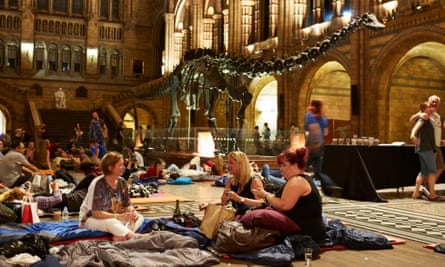
Think of an “all-nighter”, and a smoke-filled warehouse rave, somewhere on an industrial estate with only one loo, probably springs to mind. But these days it’s quite acceptable to pull an all-nighter in a classy venue wearing only a pair of pyjamas.
Sleepovers are having a bit of a moment, for adults who grew out of them long ago. The Science Museum in London runs Astronights every other month in winter (from 11 November), a strictly over-18s event where you can go behind the scenes of the collections then crash on the floor in your sleeping bag. There are workshops, a bar and movie screenings. Likewise, at the nearby Natural History Museum’s Dino Snores for Grown-Ups events (next one on 21 October) you’re free to roam around the prehistoric giants after midnight as if you’re inside a real-life version of Night at the Museum.
Meanwhile, in Manchester last year, the Royal Exchange threw its first ever A Night at the Theatre event – a programme of candlelit bedtime stories, backstage tours and a newly composed lullaby to send attendees off to sleep.
Earlier this year I slipped into my jimjams for The Sleepover, an occasional, grown-up take on a girly slumber party, with talks, comedy, pampering, goody bags, endless glasses of fizz and – yes – late-night sex chat. Astrologist Shelley von Strunckel, dressed appropriately in a silky kimono, delivered a speech on magical femininity, and because it took place in the royal suite of the St Pancras Renaissance hotel in London’s King’s Cross, we seized the opportunity for a photo shoot on the sweeping staircase used in the Spice Girls’ Wannabe video (although I’m not sure Posh would have approved of my ratty pyjama bottoms).
Writer/artist Deborah Coughlin, who puts on the event with BBC radio presenter Gemma Cairney, describes it as a place where “drinking meets thinking – it’s like walking into the pages of your favourite magazine”. Indeed, it feels rather novel to be handed a personalised star chart by von Strunckel before bedtime, instead of reading my horoscope in a paper on my own. By the time blow-up mattresses are being lined up in the main room, I’m swapping secrets with someone I’ve never met before as I snuggle down in my sleeping bag.
“It takes guts to go to a sleepover with strangers,” Coughlin says, but nonetheless they attract a diverse mix. “We’ve had people celebrating their fortieths, others their twentysomething birthdays, groups of women and people coming on their own. They all want to try something new.”
That sense of adventure is shared by Dino Snores, which starts with workshops and shows and continues through the night with live music until 3am and a movie marathon till sunrise. “It’s the Secret Cinema ethos,” says Lucy Woodbridge, head of visitor events, referring to the successful film-screening initiative that has fuelled the appetite for immersive experiences. And that’s clearly what happens when they take part in Dino Snores activities such as, say, “freaky feasts” (insect eating).
It might all sound like child’s play, but these events can offer something far more rewarding than just reliving your younger years. “It’s not about regression, it’s about knowing when you need a different kind of space and a different kind of socialising,” says Coughlin. “People want new ways to meet people and new ways to have fun.”
So there you have it: a whole new meaning to the hashtag “straight through crew”. Just don’t forget your toothbrush. Kate Hutchinson
Midnight running: ‘People want high-quality images of themselves’
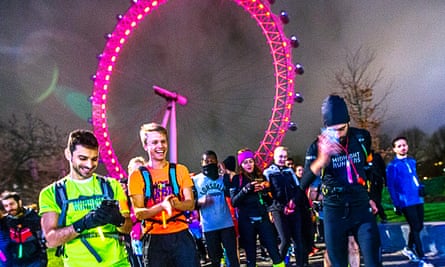
Eighteen months ago, Christian Dörffer and Greg Drach were two friends who enjoyed running late at night along the river Thames. Now they pound the same route joined by up to 400 strangers. When they recently organised a midnight, pop-up run in Barcelona, the turnout was around 4,000 people. Many ended up in a club afterwards.
“The story of Midnight Runners is the story of people bringing their friends to something they think is fun,” says Drach, who is 27. “And [a story of] social media,” adds Dörffer, 45. “What’s interesting is that the people who run with us love to be photographed. This is part of their DNA on Facebook or Instagram. They want the right kind of images of themselves and we produce really high-quality images of people doing cool stuff, like running at sunset, or in the dark in front of the Shard.”
“They put it as their profile picture,” Drach smiles, shaking his head in disbelief. “Like, ‘This is who I am. I’m a Midnight Runner’.”
Night-running clubs are growing in popularity across the UK, but the Midnight Runners believe they are the country’s biggest group, with meet-ups coordinated on Facebook. Their events are free of charge – for now; a membership fee of around £10 a month will soon apply – and the group typically meets twice a week: for a six-mile bootcamp run on Tuesday nights and a longer run on Sundays. Then, once a month on a Friday, they have a themed, dress-up run – 007, carnival, pirates. All of these are usually in London, although over the summer they are doing some trail runs further afield. The only qualification for joining is that you should comfortably be able to run six miles.
According to Facebook stats, the majority of Midnight Runners are aged between 26 and 34, and around two-thirds are female. The first members were typically foreigners working in the capital, but there is now a strong showing of Brits, too.
“I’m not sure what the proportion of single people is – I assume it’s significant,” says Dörffer, a Dane who works for an investment fund. Drach, who is Polish and creates fitness mobile apps, nods: “There have been a few relationships, which is great to see. London is a huge city and it can be quite lonely, and from our perspective it’s like, wow, these people would never have met – probably – if not for one of our events.”
Music is an essential part of the Midnight Runners experience. Dörffer makes a new playlist every month and a handful of crew captains carry portable Ultimate Ears speakers. After each run there is a social gathering, and these can become especially raucous after the monthly Friday-night event. The July meet-up saw a couple of hundred sweaty runners descend on a bar in Hackney Wick; when that closed at 3am, they went outside, turned on the portable speakers and stayed for another hour.
“It’s not so much the drink, it’s that it’s hard to speak while you are running,” says Drach. “A lot of people just have water, but the social part is central, so we probably do tap in to this trend of people finding alternative ways to have fun.”
Dörffer agrees: “I maybe know the names of 3% of our group, but we high-five each other, we hug each other. I have no idea where they are from or what they do, but everybody treats each other with respect, so that’s the special thing.” Tim Lewis

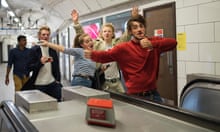
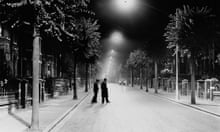





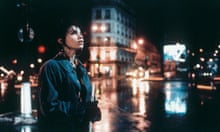
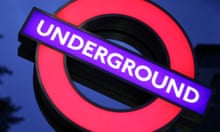

Comments (…)
Sign in or create your Guardian account to join the discussion